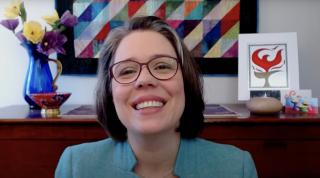Advertisement

A beautiful quilt hangs on the wall in my home office where I now do so many of my sermons and recordings and meetings.
It was made by Jennifer Centric, then a member of the First Unitarian Universalist Church of Youngstown, Ohio, where I served as minister. I hung it up early in the pandemic when I realized this office would soon become the place where I would do most all my work.
I love this quilt. It brings me joy—the cacophony of rainbow colors that signify the values of welcome, belonging, and diversity. It reminds me how we are all stitched together—an expression of our fundamental interdependence. More than this, it reminds me of the beauty and wholeness that is possible in our interconnectedness.
The pandemic continues to make the reality of our interdependence undeniable. As we begin the third year of navigating this crisis, it is wearing on us all. So many of our systems are straining under the weight. And we as people—leaders, families, children, caregivers, workers, elders—are weary.
This pandemic has tested us again and again. Repeatedly, we lost ground when we chose individual, capitalist, and nationalist approaches. The politicization of mask wearing under the guise of freedom allowed the virus to thrive. Vaccine inequity across the globe hastened conditions for more variants to emerge. This was all predictable.
A piece of incredibly good news, though, is the work of the Texas Children’s Hospital Center for Vaccine Development. Their team has developed a COVID-19 vaccine that they will license to pharmaceutical manufacturers in India, Indonesia, and other countries at no cost. They are acting in the tradition of Jonas Salk, who put public health above profit and refused to patent the polio vaccine. This reminds us of what is possible when we act from a place of interdependence.
In his “Letter from a Birmingham Jail,” the Rev. Dr. Martin Luther King Jr. wrote, “We are caught in an inescapable network of mutuality, tied in a single garment of destiny. Whatever affects one directly, affects all indirectly.” With this compelling image, King captures a truth that shapes our UU theology. Interdependence guides how we can shape our spiritual communities and energizes our commitment to social justice. Like the quilt, each of us brings our beautiful and unique self, yet we are undeniably stitched together into one whole.
As you explore this issue of UU World, I hope you will keep these images in mind and be inspired by the many ways your colleagues in the UU community are living our theology of interdependence by crafting a quilt of connection and care.